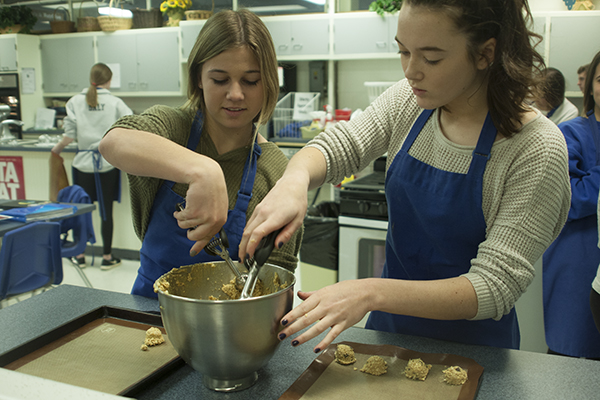Advanced electives equip students for the future

FANTASTIC FOODS: Scooping cookie dough, freshman Dani Stadler (left) and Megan Butler (right) participate in foods one. They are preparing chocolate chip oatmeal cookies. Stadler plans on advancing to Foods two in the future because she loves learning about different foods and how to make them.
December 22, 2017
Some students take electives because they have to. Some students take electives because they want to. In any case, throughout the process of taking electives such as fashion and foods, sometimes the beginner levels just aren’t enough. Advanced electives not only spark passions in students, but prepare them for their futures.
Senior Jessica Peters believes she has greatly benefited from Advanced Fashion. As a child, Peters says she had always wanted to learn how to sew, but she never had the time to pursue such an activity. When she arrived at South however, Peters says she realized that she would now have the opportunity to learn how to sew through GBS’s fashion program. According to Peters, she has taken fashion ever since.
“When I got to high school and realized that they offered this class that would fit in my schedule and I didn’t need to buy my own sewing machine, I thought it would be perfect for me,” Peters said.
Sparking an interest in the students is just the first step of participating in advanced electives. Foods Instructor Kelli McDonald says that after learning kitchen basics in Foods 1, the transition to Foods 2 highlights the application of skills learned in the first class. McDonald says students are given more independence and room to express their creativity through their cooking.
“[Foods 2] is a lot of independent cooking, a lot of critical thinking and problem solving,” McDonald said. “You really get to see the kids grow because they should have that basis in Foods 1.”
According to McDonald, Advanced Foods is comprised of half baking and pastry lessons and half international cooking with units focusing on Italian, Mexican, and Asian cuisine. McDonald says that students spend the majority of their time in the kitchen rather than a typical classroom setting.
“The kids are usually in the kitchens every day,” McDonald said. “There are probably five days throughout the semester that the kids aren’t in the kitchen.”
Junior Eleni Copetas took foods during her freshman year and is currently taking Advanced Foods and Nutrition.
“Foods 2 is a lot more hands-on,” Copetas said. “It’s different from Foods 1 in the sense that there’s a lot less projects. It’s a lot more realistic. You can apply [what is learned] more in the class.”
According to Fashion Instructor Melissa Regan, the Apparel and Design program at South consists of five levels, the first level being open to all students, where they gain basic sewing skills. Regan says that levels two through five are considered part of Advanced Fashion.
“It’s a stacked class which means that you’ll have someone who is only on their second semester of Fashion working with somebody who’s on their fourth or fifth,” Regan said. “It’s a really unique setup.”
Regan believes that what sets Advanced Fashion apart from other electives is its ability to prepare students interested in design for their future careers.
“For students who actually do want to pursue fashion as their career and would like to go to a design school or even a school that has a similar program, many of them require a portfolio to be built.” Regan said. “Students have the chance in class to build that portfolio.”
Similarly to fashion, foods equips students with skills for the future. Because of the course’s focus on the field of professional culinary arts, McDonald says that students are ServSafe certified at the very beginning of the class. This certification by ServSafe is based on a food handling assessment developed by the National Restaurant Association, according to servsafe.com, and is helpful in food industry jobs.
“If [students get certified] in class, they’re going to get hired over someone else who doesn’t have this certification,” McDonald said. “Then, the restaurant doesn’t have to spend their money on taking the time to train that person.”
By gaining experience in higher-level foods electives, senior Mia Pitzaferro can apply her skills to her future, whether it be moving on to culinary school or simply adopting a new hobby in cooking.
“I wanted to go to culinary school for three years,” Pitzaferro said. “I decided to follow in Ms. McDonald’s footsteps and become a Family Consumer Science Education teacher, so I’ll still follow my passion of being in the kitchen, but as well as teaching and helping kids follow their passion.”


